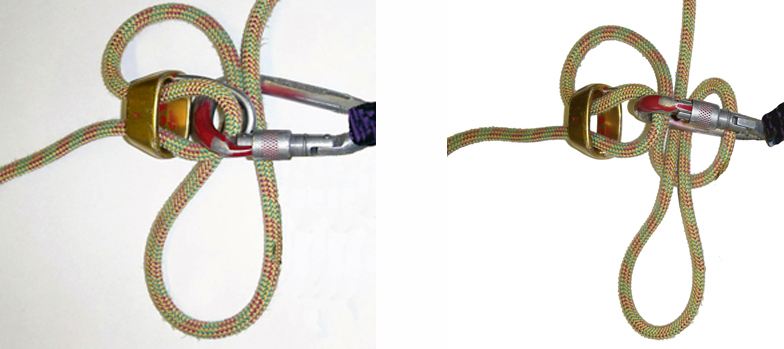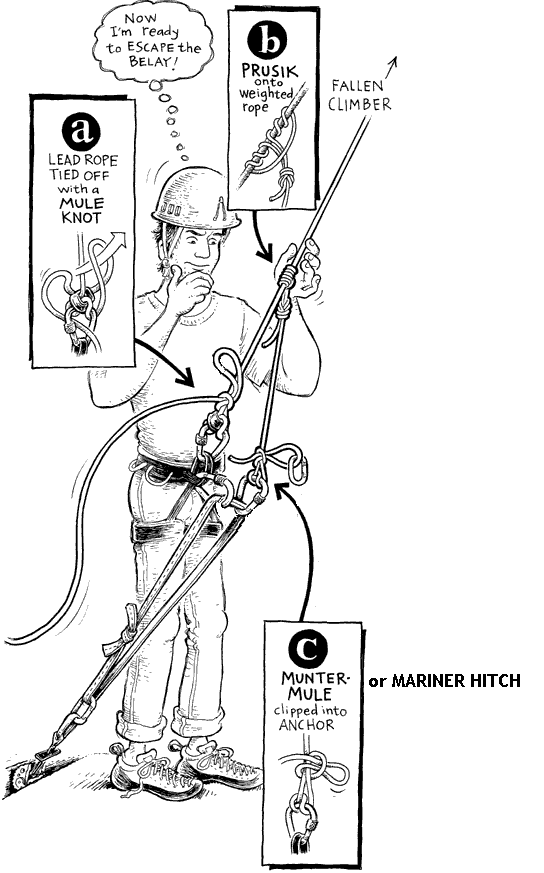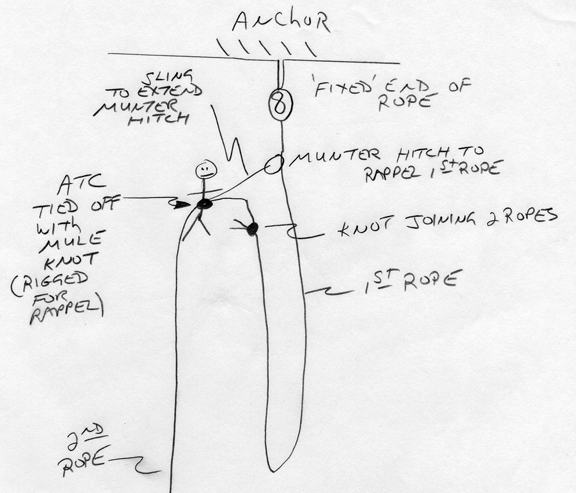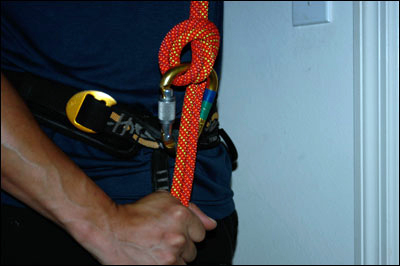
Introduction
This represents a small number of tips among a vast knowledge
base
you need to be competent at self-rescue and is no means a
substitute for learning this hands-on with an experienced instructor.
A good book on the subject is David Fasulo's Self-Rescue. https://www.amazon.com/Self-Rescue-How-Climb-David-Fasulo/dp/0762755334
Competently knowing how to use an assisted braking belay device such as
a Petzl GriGri makes many of these techniques much easier and safer.
Get belayer’s hands free.
a. Tie a mule knot by passing the rope through the belay biner
twisting it and passing the end through (shown below and illustrated
video at: http://vimeo.com/17441295).
b. Then tie an overhand in the loop as a back-up or a half-hitch back
through the biner.

2. “Close the loop” or back-up system.
a. Tie a figure-8 on a bight on the rope that’s on the belayer’s side of the belay device and clip this bight knot to the anchor as a back-up (not shown below). You do this because you don't want to leave the climber hanging off only a 6mm cord.
3. Transfer load of the climber to the anchor.
a. Place a prusick hitch on the rope that’s on the climber’s
side of
the belay device.
b. Attach this prusick to the anchor with a separate locking
binner with a Munter mule knot or a mariner’s knot. (A long cordelette,
prusicks, or sling girthed to the prusick all work for this.)

Mariner's hitch -- clip the two ends together (image on right) with a
biner and to the anchor.
c. Slide the prusick up the rope to get it as tight as possible and carefully unload the mule knot at the belay device, transferring the load to the anchor.
4. Escape the belay.
a. The belayer may now take the rope out of the belay device and escape.
5. Regaining the belay.
a. Take rope between prusick and eight on a bight and run
through
belay device as you would to belay.
b. Get the rope tight and tie a mule knot by passing the rope through
the belay biner twisting it and passing the end through.
c. Then tie an overhand in the loop as a back-up or clip a biner to
loop.
d. Release the Munter-mule/mariner’s knot to transfer weight to
climber/anchor.
e. Remove the prusick knot.
f. Untie the back-up eight on a bight.
g. Carefully unload the mule knot at the belay device, transferring the
load back to the climber/anchor.

The Munter pop is the simplest, least gear-intensive way to rappel past a knot.
1. Pull up the rope and install your rappel device on the rope
immediately under knot tying the two ropes together. Clip to harness
and tie it off with releasable mule hitch.
2.
Install locker (MUCH easier with a notchless biner) with Munter Hitch
on rope and clip to harness with a sling long enough (4 ft) to put the
Munter up just above head level (high but still reachable).
3. Rappel on extended Munter until hanging from tied-off ATC (the
extension will allow the tied-off ATC to become weighted before the
knot reaches the Munter).
4. Unlock the Munter biner, detach its connecting sling, and wiggle the
biner until it "pops" the Munter off the weighted line (try it---you
can do this---the Munter does not have to be unweighted. (If you can't
pop it just unclip the sling and leave the biner).
5. Continue rapping on the rappel device, after undoing the backup
loop.
Practice
this in a controlled setting so you know how long the Munter extension
has to be. It is harder if the knot reaches the
Munter
before the rappel device below the knot is fully weighted but even then
you can pop the Munter by opening the gate and wiggling the biner out.

This is useful when you have to haul a climber over a section that they can not climb or to haul an injured climber. It is simpler to set-up if you are using a belay device such as a Black Diamond ATC Guide or a Petzl Reverso in auto-locking mode then you don't have to use the Garda hitch.

|
||||||||||
|
|||||||||||
|
To make this system safer you can tie a clove hitch in the rope below your footloop and attach this to your belay loop. By rolling the clove hitch up every few moves you will have a back-up should the waist prusick fail. |
|||||||||||
| - Mechanical ascenders | |||||||||||
| As well as prusick there are a couple of lightweight ascender on the market that will make your life easier. The petzl Tibloc is the lightest and simplest but very aggressive on ropes. Whilst a Wild country Ropeman is slightly heavier but less aggressive on ropes. | |||||||||||
|
|
||||||||||
|
|
|||||||||||
Miscellaneous
A common occurance is someone dropping a belay device. So how do you rappel down? Munter hitch.
